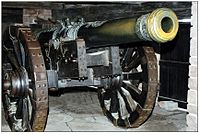- Minion (cannon)
-
Part of the series on Cannon History Artillery in the Song Dynasty
Artillery in the Middle Ages
Naval artillery in the Age of Sail
Field artillery in the US Civil WarOperation By country English cannon
Japanese cannon
Korean cannonBy type Hand cannon
Autocannon
Falconet
Minion
Saker
Demi-culverin
Culverin
Demi-cannon
Field gun
Howitzer
Mortar
Bombard
BasiliskThe minion (from the French word for small) was a type of small cannon used during the Tudor period[1] and into the late 17th century.[2] The minion was of a small bore typically 3-inch (76.2mm) and fired a 5-pound cannon ball. It saw action in the English Civil War as an antipersonnel weapon and was known as a Minion Drake,[3] derived from either the Latin word for dragon or from the famous seafarer Sir Francis Drake.
The minion constituted the main armament of the faster and more maneuverable Elizabethan galleons such as Drake's Golden Hind[4], along with the falconet. The supply ships that accompanied the Armada had similar guns,[5] but the Spanish treasure fleet bringing gold back from the new world carried heavier armaments such as the demi-culverin and demi-cannon[6] and relied on their size and weight in battle as they were purpose-built warships rather than merchant ships pressed into service.[7]
The Pilgrim Fathers brought a minion with them on the Mayflower, along with a saker and several smaller cannons. They later installed these in the fortified meeting-house Myles Standish built to defend the town from the French and Spanish.[8]
During the Age of Sail minions were used to repel boarding parties although larger caliber guns such as the carronade were becoming increasingly popular due to their ability to disable enemy vessels. Minions remained in service as man-of-war quarterdeck guns until 1716 when George I appointed Albert Bogard to redesign the Royal Navy's artillery.Citations and notes
- ^ http://www.seatofmars.com/elizabethanweapons.htm
- ^ http://www.probertencyclopaedia.com/F_MINION.HTM
- ^ http://www.johnhampdensregiment.org.uk/pages/artillery.html
- ^ http://www.goldenhinde.org/
- ^ http://www.teignmuseum.org.uk/pages/museum/maritime/shipwrecks.html
- ^ Duff Hart-Davis, Spanish Armada p.199
- ^ http://www.orlandosentinel.com/media/graphic/2006-10/25797591.jpg
- ^ http://www.mayflowerhistory.com/History/plymoth3.php
External links
Categories:- Cannon
- Naval artillery
- English Civil War weapons
Wikimedia Foundation. 2010.

